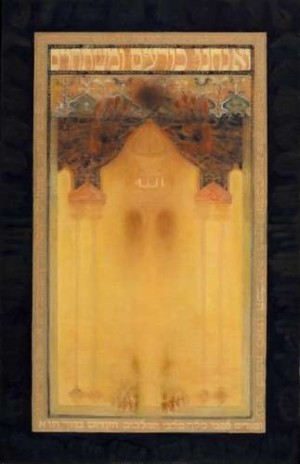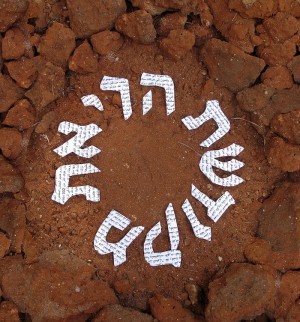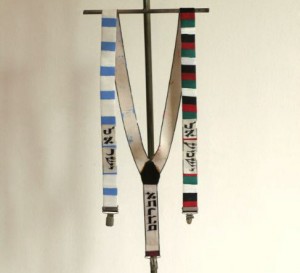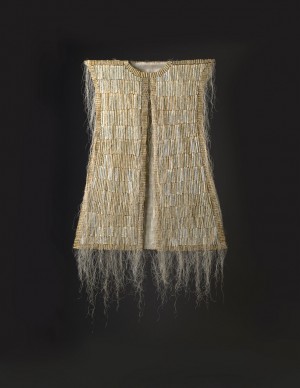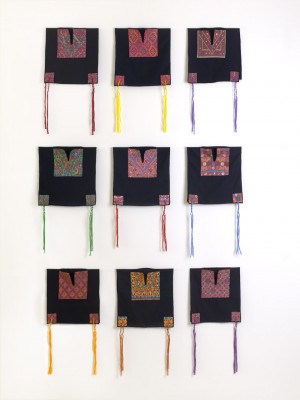Appropriation or Reconciliation? Islamic Elements in the Art of Israeli Religious Women
In recent years, there has been a trend (albeit a marginal one) in the religious world, mainly among religious settlers on the West Bank, to reach out and establish a religious dialogue with Palestinians. “Kolech–Religious Women’s Forum”; Rabbi Menachem Froman from the settlement of Tekoa; poet Nachum Pachnik from the settlement of Kiryat Arba and his organization “Eretz Shalom” (Land of Peace); poet Eliaz Cohen’s “Yerushalom”; and poet Elhana Nir’s “Ohel Avraham” have all generated small dialogues between Jewish and Muslim women, rabbis and sheikhs, and other groups, all in the heart of the Israel-Palestinian conflict.
At the same time, religious artists — particularly women artists — within green-line Israel have sought to reclaim a common, local, cultural space (artistic, religious and concrete ) whereby religion and culture constitute a common ground for connection, and not only a platform for dispute and conflict. These are efforts not at appropriation, but at reconciliation. We will examine three such artists here.
Ruth Kestenbaum Ben-Dov: Hosting Culture
The series of prayer rugs/ark curtains (parochot) by Ruth Kestenbaum Ben-Dov (b. 1961) was painted in oil on canvas between 2003–2005. According to the artist, this series of works, named “Prayer Rugs,” is a variation on a parochet from the 17th century now in the collection of the New York Jewish Museum. The parochet is made like a Muslim rug and invites an encounter between East and West and between Judaism and Islam. It seems to transform from parochet to a rug, to a window, to a view and finally — a piece of earth.
The verses quoted in “Prayer Rug 2” in Hebrew and in Arabic, originate from the Aleinu prayer, which includes racist and chauvinistic sayings that create separation and polarization between religions: “For He has not made us like the nations of the lands and has not emplaced us like the families of the earth; For He has not assigned our portion like theirs nor our lot like all their multitudes”; “For they bow to vanity and emptiness and pray to a god which helps not.” Yet the verse “But we bend our knees, bow, and acknowledge our thanks,” originating in the same prayer and appearing on the top of the work, constitutes a link to the daily Muslim way of worship. (Where the name of God appears in Hebrew in the original parochet, it appears in Arabic in Kestenbaum Ben-Dov’s work.)
In “Prayer Rug 5,” the view is a close-up of the ground, on which is a shadow of a kneeling figure, which is repeated in this series and is reminiscent of the blurry imagery in the works of American artists Jasper Johns (b. 1930) and Julian Schnabel (b. 1951). The text in the frame derives from the Nehenin Praise, in which one gives thanks for “A delightful, good and wide land that you wanted and gave to our fathers….” According to the artist, this praise also includes expressions that relate to everyone who lives on this land, together with expressions that indicate the heart of the conflict: “Please have mercy … on Jerusalem, your city, and Zion, residence of your pride” (From the Grace after Meals). The combination of earth and the rectangular shadow in “Prayer Rug 6” which, according to the artist, symbolizes a baby’s grave (a motif borrowed from the dedication on the original parochet), brings the viewer back from utopia to harsh reality.
In her series of works “Remembrance” (2005–2007), Kestenbaum Ben-Dov uses the Jewish tradition of leaving part of a new house the size of a square forearm, bare of plaster, in memory of the destruction of the Temple. This part represents the empty space caused by the destruction, and believers have faith that it will be filled.
The work “Destruction/Home” consists of a wooden frame with fourteen paintings inside it. Twelve of them are arranged in two columns of squares, meaning, six pairs, one beneath the other, and two of them are rectangles located at the bottom of the piece. The images change from Temple to Home, to a face and, finally, to soil, and their development is also expressed in colors that range from shades of blue to colors of skin and flesh, to the colors of the soil. The figures on the right-hand side of the piece correspond to figures on the left-hand side: On the opposite side of a painting hinting at an unplastered wall (symbol of the destruction), and under it, an obscure image of the Temple, obscure paintings of the Dome of the Rock appear, decorates shape that, as mentioned, decorates the houses of many Muslim believers.
The dichotomy changes in the next pair of paintings, and the Temple appears in front of the erased Dome of the Rock. This way, the pairs keep describing destruction and building, deletion and existence: The private (Jewish) home, built on the remains of another home (Palestinian); a destroyed house in front of the facade of “the other,” and so forth. Later, the contrasts become more brutal. The artist says that at first, she planned to have two paintings facing each other: The complete face and the defaced face of “the other,” but she was unable to do this and therefore put her own face in two positions: complete and defaced (one with bright eyes and one with dark eyes). The division in two columns of square is broken by the rectangles in a joint ending, where all that is left is a description of the dry desolate soil.
Nechama Golan – Tears of Ground
Nechama Golan (b. 1947) uses printed religious texts and often deals with the relations between Jewish and Muslim culture. In her work, “You are consecrated to me,” Hebrew letters filled with Arabic text are designed as a circle on the ground and form the beginning of Jewish marriage ceremony: “you are consecrated to me…” The work shifts between several layers of interpretation: Golan faces the sanctity of the marriage with the sanctity of the ground. Since ancient times, marriage has been linked to the building of the nation. The sanctity of the ground and the metaphorical act of coitus are images that were common in both Jewish, Zionist and Israeli culture, and symbolized admiration, conquest and building.The use of the two languages, Hebrew and Arabic, expresses a complex reality whereby two nations claim ownership of the same piece of land.
In another work, we see a canopy of letters covering the ground, which invites reflection on the importance of ownership as opposed to the completeness of the building. The name, Tears of Ground, is reminiscent of the Israeli popular song by Dan Minster and Yoni Rechter, “Tears of Angels,” which has become a hymn at Memorial Day ceremonies in Israel. The work shows two figures of angels made out of polyester and broken glass, with light cords running through them. A Star of David and a crescent with a star distinguish between the “Jewish” angel and the “Muslim” angel. According to the artist, these angels are used here as mediators that remove the testimony from the human sphere to a divine sphere where the memory and historic faith of two peoples unite, fated to live together.
In the piece “I have made you a father of many nations…” (According to Genesis 17:5), Golan explores the mythological connection between the religions. The piece refers to the myth of Patriarchs and Matriarchs that is common to the two nations. Suspenders, used to hold up pants, serve as a metaphor for the common establishment of a tradition that might loosen without being firmly held on both sides
Andi Arnovitz – Garments of Reconciliation
In 2001, during the second Intifada, Andi Arnovitz (b. 1959) created a completely un-wearable garment as a metaphor for maternal sensitivity. According to the artist, the work was meant to symbolize the universal will of all mothers to protect their children from violence. The small garment was designed in the style of ceremonial garments for Afghani children. The vest was ornamented with verses from Psalms, the Jewish Traveker’s Prayer and protective talismans and Kabbalistic charts.
This topic was expanded upon when in 2009, Arnovitz created “Prayer Vest,” as a Jewish response to explosive belts used by Muslim suicide-martyrs (“Shahids”). Her vest is made of pages from worn out prayer books she purchased in the ultra-orthodox neighborhood, Me’a She’arim, in Jerusalem. She rolled each page carefully, and wrapped each scroll with strings, which she tied one by one to Japanese paper creating the vest.
In the series “Garments of Reconciliation,” Arnovitz aims at creating a dialogue (even if mainly symbolic) between Jews and Palestinian by means of a joint creation of “Small Talith” or “Tzizit”. Arnovitz told me:
“I went to the old Arab market in Jerusalem and borrowed 30 tapestries from my friend Mazen, a Palestinian. These tapestries were embroidered by women from different Palestinian villages. Since they were ancient and scarce, I did not want to cut them, so I took them to Western Jerusalem, to a modern Jewish print shop, where they scanned them and digitally printed them on linen. I then returned the original tapestries and took the scanned linen to Ibrahim, another Palestinian who owns a textile shop. I bought black cotton manufactured in Egypt, and he took the cotton and scanned tapestries to a sewing shop in Ramallah, where they were sewn by other Palestinians. When they were completed, I gave them to a young Israeli student who tied the Tzizit fringes for me. Throughout the process, the work of art passed from hands of Jews to hands of Arabs and back again. It was important for me that the garments were small, because education for peace starts at a young age.”
The Productive Look
Revisionist historian Zohar Maor has challenged the conventional distinctions between what is usually described as the Zionist “main road” that is taken as modern, rational and liberal, and Zionist right-wing perceptions that are usually defined as anti-liberal. Works by religious artists such as these who have been discussed here likewise undermine the common distinction between left and right in Israeli politic culture.
The oscillation between viewing the “me” and its relationship to the “other” in the works that were discussed can be characterized as what the film critic and theoretician Kaja Silverman described as a “productive look.” Based on Lacan’s ideas, Silverman describes the productive look as one that allows the viewer to transform and make her own that which would have been violently rejected, while also recognizing as other that which may have previously been seen as me. The productive look, Silverman explains, incorporates into the viewer’s memories aspects that are not the viewer’s own, allowing the viewer to participate in the other’s desires, struggles and suffering; to experience their pain and past reverberating in his present.
The religious artists whose works we have examined are not ambiguous about their religiousness and are rooted deeply in tradition, yet they create works that call for dialogue between Jewish and Palestinian cultures. Stress, lack of trust and struggle, on one hand, or renunciation of narratives on the other, are converted in a suggestion to create a joint realistic, artistic and theological space — a space that does not blur boundaries and disagreements, but aims at creating a dialogue based on a deep understanding of them.
These three artists have found a way to include the “other” in their traditional Jewish world view. They deal with the tension existing between Judaism and Islam, and do not blur the differences between the two religions, but their work stresses the aspects common to both. They present a fascinating combination of a conservative world and a profoundly non-conformist spirit.
![[the current issue of ZEEK]](../../image/2/100/0/5/uploads/leftistethicistgraphic-52842c6a.png)
- 5000 Pages of Zeek
- Founded in 2001, Zeek was the first Jewish online magazine, and we have over 5000 pages online to prove it, all available free of charge. Read more in the Archive.
More articles by
David Sperber
More articles in
Arts and Culture
- Euphoria, Curiosity, Exile & the Ongoing Journey of a Hasidic Rebel: A Q & A with Shulem Deen
- Poet Q, Poet A: Jews Are Funny! Six Poets on Jewish Humor, Poetry & Activism and Survival
- Tackling Hate Speech With Textiles: Robin Atlas in New York for Tu B’Shvat
- Fiction: Angels Out of America
- When Is an Acceptance Speech Really a Speech About Acceptance?


